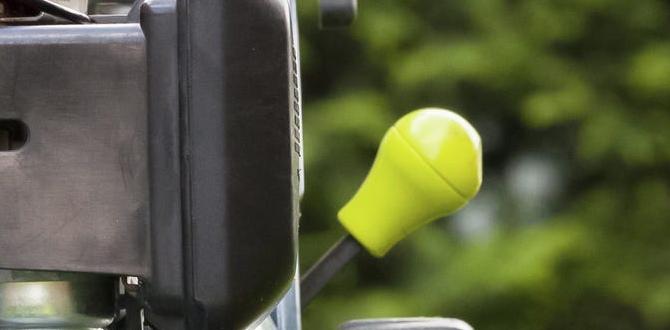Quick Summary:
Understanding nail gun parts is key for safe and effective use. This guide breaks down each component, explaining its function so you can confidently operate, maintain, and troubleshoot your nailer for any DIY project.
Hey there, fellow DIYers and woodworking enthusiasts! Jack Shaffer here, your go-to guy for all things tools here at Nailerguy. Ever stared at a nail gun, marveling at its power, but feeling a little unsure about all those different bits and pieces? You’re not alone! Sometimes, these amazing tools can seem a bit complex, especially when you’re just starting out. This guide is designed to demystify your nail gun. We’ll take a friendly, step-by-step look at each crucial part, explaining exactly what it does and why it matters. By the end, you’ll feel more comfortable than ever operating your nailer, ready to tackle that next project with confidence!
Table of Contents
Demystifying Your Nail Gun: A Part-by-Part Exploration
Nail guns are incredible tools that can speed up projects and deliver professional results. But like any tool, knowing its inner workings makes you a better, safer user. Let’s break down the common parts of a nail gun and understand their vital roles. We’ll cover everything from the basics you see on the outside to the intricate mechanisms that make them fire.
1. The Trigger Mechanism: Your Control Center
The trigger is how you tell the nail gun to do its job. It’s the most crucial part for user interaction. Most modern nail guns have safety features built into the trigger system to prevent accidental firings.
- Trigger Switch: This is the part you press. It initiates the firing sequence.
- Safety Contact/Nose Contact: This is a movable piece, usually at the tip of the gun, that must be pressed against the workpiece before the trigger can activate the nailing action. This is a critical safety feature. Different types of firing modes exist, which we’ll touch on later, but this contact nose is universal for safety.
- Firing Actuator: When you pull the trigger and the safety contact is engaged, this internal mechanism trips the air valve (in pneumatic guns) or electrical system, firing the nail.
2. The Magazine: Holding the Ammunition
The magazine is where you load the nails. It’s designed to hold them in a specific order so the nail gun can feed them one by one into the firing chamber.
- Magazine Body: This is the main housing for the nails. It’s usually made of durable metal or high-impact plastic.
- Nail Track/Feeder: This is the channel within the magazine where the nails slide. The design of this track is specific to the type and size of nails the gun can accept (e.g., straight, angled, brad nails, finishing nails).
- Follower: This is a spring-loaded piece inside the magazine that pushes the nails forward, ensuring the next nail is always in position to be fed into the firing chamber.
- Loading Latch/Release: A lever or button that allows you to open the magazine for loading and to release tension from the follower spring when not in use.
3. The Firing Mechanism: The Heart of the Operation
This is where the magic happens – the part that forcefully drives the nail into your material. The design varies depending on whether your nail gun is pneumatic, electric, or gas-powered, but the principle is the same: rapid force.
3.1 Pneumatic Nail Gun Firing Components (Most Common)
Pneumatic guns use compressed air to drive nails. Here are the key parts involved:
- Air Cylinder: A chamber where compressed air is stored.
- Piston: A sliding component that moves rapidly within the air cylinder.
- Driver Blade/Nail Probe: A thin, sturdy piece of metal attached to the piston. When the piston is driven forward by air pressure, the driver blade strikes the head of the nail, pushing it through the material.
- Air Valve: A critical component that controls the flow of compressed air into and out of the air cylinder. When triggered, it releases a precise burst of air to drive the piston and driver blade.
- O-rings and Seals: These are essential for preventing air leaks and ensuring the pneumatic system functions efficiently and powerfully.
3.2 Electric/Cordless Nail Gun Firing Components
Electric and cordless nailers often use a motor and flywheel system or a battery-powered piston mechanism.
- Motor: Powers the driving action.
- Flywheel (on Impulse/Impact models): A spinning disc that stores energy. When triggered, it’s released to drive a Piston.
- Battery Pack: Provides power for cordless models.
- Spring-Loaded Piston: Similar in function to pneumatic versions but powered electrically.
3.3 Gas-Powered Nail Gun Firing Components
These use a combustion process for power.
- Fuel Cell/Gas Canister: Contains the combustible fuel.
- Ignition Mechanism: Sparks the fuel.
- Combustion Chamber: Where the fuel ignites, creating a rapid expansion of gas.
- Piston/Striker: Driven by the expanding gas.
4. The Air Inlet (for Pneumatic Guns): Connecting to Power
This is where you connect the air hose from your compressor to the nail gun.
- Quick-Connect Coupler: The fitting that allows for quick and easy attachment and detachment of the air hose.
- Air Regulator (on compressor): While not part of the nail gun itself, controlling the air pressure is vital. Too little pressure means nails won’t fully seat; too much can damage the tool or workpiece. A general rule of thumb for many nail guns is to operate between 70-120 PSI, but always check your tool’s manual. For more on safe air pressure, check out resources like OSHA’s guidelines on pneumatic tools.
5. The Exhaust Port (for Pneumatic Guns): Releasing Spent Air
After the air drives the piston, it needs to escape. The exhaust port vents this used air.
- Exhaust Port: Usually a small opening, often with a directional deflector.
- Air Deflector: Some nail guns have adjustable deflectors that allow you to direct the exhaust air away from your face, preventing discomfort and debris from blowing into your eyes.
6. The Depth Adjustment Mechanism: Controlling Nail Depth
This feature allows you to control how deep the nail is driven into the material.
- Adjustment Knob/Wheel: Typically located near the trigger or nose of the gun. Turning it changes the distance the driver blade travels or, in some models, adjusts air pressure to the firing cylinder.
- Depth Setting: You can set it for nails to sit flush with the surface, slightly recessed for putty filling, or proud (sticking out slightly) if needed. Precision is key for a clean finish.
7. The Safety Features: Ensuring Safe Operation
Modern nail guns come with multiple safety features designed to prevent accidental discharge. These are paramount for user protection.
- Contact Trip Mechanism (Safety Noses): As mentioned earlier, this requires the tip of the gun to be pressed firmly against the material before the trigger can fire.
- Sequential Firing Mode: This is the safest mode for general use. The gun fires only one nail each time the trigger is pulled and the safety nose is depressed.
- Contact Firing Mode (Bump Fire): In this mode, you can hold the trigger down and rapidly fire nails by just bumping the safety nose against the workpiece. This is faster but requires more caution and is generally used for applications like roofing or framing where speed is important and surface damage is less of a concern. Always refer to your tool’s manual to understand how to switch between modes, and only use modes suited to your task and comfort level.
- Lock-out Mechanisms: Some guns have a trigger lock or a mechanism that prevents firing when empty.
Understanding Different Nail Gun Types and Their Parts
While the core components are similar, specific nail gun types have unique features due to their power source and intended use.
Pneumatic Nailers
These are the workhorses, powered by compressed air from a compressor. They are known for their power, speed, and durability.
Key Parts: All parts mentioned above, with emphasis on air cylinder, piston, driver blade, and air valve.
Electric Corded Nailers
Plug into a standard outlet. They offer convenience without the need for a compressor but can be limited by cord length.
Key Parts: Motor, driver mechanism (often spring-loaded or electromagnetic), trigger, magazine assembly.
Cordless Electric Nailers (Battery-Powered)
These offer the ultimate in portability. They use battery packs to power their driving mechanism, which can be motor-driven or use compressed gas stored in a canister.
Key Parts: Battery pack, motor, driver mechanism, magazine assembly.
Cordless Gas/Fuel Cell Nailers
These use a small, disposable fuel cell and a battery for ignition. They are highly portable and powerful, often favored for framing and trim work.
Key Parts: Fuel cell, fan, ignition system, battery, piston assembly, magazine assembly.
Essential Maintenance for Longevity
Taking good care of your nail gun parts ensures it performs reliably and safely for years to come. Regular maintenance is simple and highly effective.
1. Cleaning
- Exterior: Wipe down the tool with a damp cloth to remove dust and debris.
- Magazine Track: Keep the nail track clean and free of obstructions. Nails can sometimes get jammed, so ensuring a clear path is crucial.
- Safety Nose: Make sure the contact tip (safety nose) moves freely and isn’t clogged with sawdust or paint.
2. Lubrication (Pneumatic Guns)
- Air Tool Oil: For pneumatic nailers, a few drops of specialized air tool oil should be added to the air inlet daily, or as recommended by the manufacturer. This lubricates the internal moving parts like the piston and driver blade. Most compressors also have automated oil lubricators.
- Do Not Over-oil: Too much oil can actually hinder performance or get into your workpiece.
3. Inspection
- O-Rings and Seals: Periodically check for wear or damage that could cause air leaks.
- Driver Blade: Look for any nicks, bends, or excessive wear. A damaged driver blade can lead to nail jams or improperly driven nails.
- Magazine Mechanism: Ensure the follower moves smoothly and the springs are intact.
- Trigger and Safety Contact: Test that both operate smoothly and reliably.
For detailed maintenance schedules and specific cleaning instructions, always consult your nail gun’s owner’s manual. Many manufacturers provide excellent guides, such as those found on DeWalt’s support page.
Troubleshooting Common Nail Gun Issues
Even with proper maintenance, you might encounter a snag. Knowing the common issues and their probable causes can save you a lot of frustration.
| Problem | Potential Causes & Solutions |
|---|---|
| Nail Gun Not Firing |
|
| Nails Not Driving Fully (Sitting Proud) |
|
| Nails Jamming in Magazine or Firing Chamber |
|
| Air Leaking (Pneumatic) |
|
| Driving Nails Too Deep |
|
Conclusion: Your Nail Gun, Now Understood
So there you have it! We’ve journeyed through the essential parts of a nail gun, from the trigger you interact with to the intricate firing mechanism that drives each nail. Understanding these components isn’t just about satisfying curiosity; it’s about empowering yourself as a user. You can now approach your tool with more confidence, perform basic maintenance to keep it running smoothly, and even troubleshoot minor issues that might arise.
Remember, safety is always the top priority. Always engage the safety features, use the correct nails, and keep your workspace clear. A well-understood and well-maintained nail gun will not only make your projects more efficient but also more enjoyable. Whether you’re building a deck, framing a wall, or adding delicate trim, you’re now better equipped to handle your nailer like a pro. Happy building!
Frequently Asked Questions (FAQ)
Q1: What is the most important safety feature on a nail gun?
The most critical safety feature is the contact trip mechanism (also known as the safety nose or contact element). This prevents the nail gun from firing unless its tip is pressed firmly against the surface you are nailing into, significantly reducing the risk of accidental discharge.
Q2: How do I know if I’m using the right nails for my nail gun?
Always refer to your nail gun’s owner’s manual. It will specify the exact size, diameter, angle, and collation type (e.g., glued, wire collation) of nails compatible with your tool. Using the wrong nails can cause jams, damage the tool, or lead to poor performance.
Q3: Do I need to lubricate all types of nail guns?
No, only pneumatic (air-powered) nail guns typically require regular lubrication with specialized air tool oil. Electric, battery-powered, and gas-powered nail guns have their own internal lubrication systems or don’t require user-added oil. Over-oiling a pneumatic gun can also cause issues.
Q4: What is the difference between sequential and contact firing modes?
Sequential firing mode requires you to press the safety contact against the wood then pull the trigger to fire one nail. This is safer for general use. Contact firing mode (or bump firing) allows you to hold the trigger down and fire nails by repeatedly bumping the safety contact against the material. It’s faster but requires more skill and caution.
Q5: Can I use my nail gun without an air compressor?
This depends on the type of nail gun. Pneumatic nail guns require an external air compressor. Electric (corded or cordless) and gas-powered nail guns are self-contained and do not need a compressor.
Q6: My nail gun is making a hissing sound but not firing. What could be wrong?
A hissing sound often indicates an air leak in a pneumatic nail gun. This could


